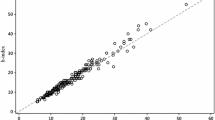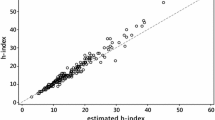Abstract—
The results on the informativeness of the widely known and easy-to-use Hirsch citation index are described briefly, and the advantages and disadvantages are noted. As an alternative, four new three-dimensional citation indices are presented: the M-index, the weighted M-index, the G-index of superhigh citation, and the weighted G-index. For ease of comparing the publication activity of scientists, their unidimensional pseudonorms (estimates) have been introduced. The indicators introduced are easy to use and include the methodology of the Hirsch index, which is familiar to the scientific community; but are significantly more informative than the latter.
Similar content being viewed by others
REFERENCES
J. E. Hirsch, “An index to quantify an individual’s scientific research output,” Proc. Nat. Acad. Sci. U. S. A. 102 (46), 16569–16572 (2005).
Google Scholar. https://scholar.google.com/.
eLIBRARY.ru. https://elibrary.ru/.
Astrophysics Data System. http://adsabs.harvard.edu/.
J. Bar-Ilan, “Which H-index? A comparison of WoS, Scopus, and Google Scholar,” Scientometrics 74 (2), 257–271 (2007).
https://webarchiveorg.ru/.
O. V. Mikhailov and T. I. Mikhailova, “Hirsch index in assessing the activity of a scientist in a national research university,” Vestn. Kazan. Tekhnol. Univ., No. 11, 485–487 (2010).
R. Tagiew and D. I. Ignatov, “Behavior mining in H-index ranking game,” CEUR Workshop Proceedings 1968, 52–61 (2017).
V. Imaev, “Technologies to increase the Hirsch index and the development of simulation science,” V Zashchitu Nauki, No. 17, 38–51 (2016).
N. Demina, “Hirschemania and Hirschefobia,” Troitskii Variant—Nauka, No. 218, 6 (2016).
O. V. Mikhailov, “A new version of the Hirsh index: The j-index,” Herald Russ. Acad. Sci. 84 (3), 217–220 (2014).
L. Egghe, “Theory and practice of the G-index,” Scientometrics 69 (1), 131–152 (2006).
M. I. Kosmulski, “I-a bibliometric index,” Forum Akademickie 11, 31–32 (2006).
G. Prathap, “Hirsch-type indices for ranking institutions’ scientific research output,” Current Sci. J. 91 (11), 1439–1440 (2006).
T. Jones, S. Huggett, and J. Kamalski, “Finding a way through the scientific literature: Indexes and measures,” World Neurosurgery 76 (1), 36–38 (2011).
A. S. Kholodov, “Citation indexes of scientific works,” Herald Russ. Acad. Sci. 85 (2), 122–131 (2015).
N. A. Mazov and V. N. Gureev, “Alternative approaches to assessing scientific results,” Herald Russ. Acad. Sci. 85 (1), 26–32 (2015).
A. V. Kuznetsov, “To start, it is necessary to take order in the existing RSCI system,” Vestn. Ross. Akad. Nauk 84 (3), 268–269 (2014).
L. Waltman and N. J. van Eck, “Robust evolutionary algorithm design for socio-economic simulation: Some comments,” Comput. Econ. 33, 103–105 (2009).
J. E. Hirsch, “An index to quantify an individual’s scientific leadership,” Proc. Natl. Acad. Sci. U. S. A. 102 (46), 16569–16572 (2005).
H. Weyl, Philosophie der Mathematik (GITTL, Moscow, 1934) [in Russian].
A. Heyting, Intuitionism (North-Holland Publishing Co., Amsterdam, 1956).
A. Fraenkel and Y. Bar-Hillel, Foundations of Set Theory (North-Holland Publishing Co., Amsterdam, 1958).
V. V. Mironov, “Informatization of education: Achievements and problems,” Informatizatsiya Obrazovaniya Nauki, No. 4, 3–18 (2017).
ACKNOWLEDGMENTS
The author is grateful to K.V. Mironova, Cand. Sci. (Eng.), for the idea to write this article, useful tips in its implementation, and assistance in analyzing the large amount of information on this problem on the Internet, as well as to A.N. Vlasov, Dr. Sci. (Eng.), and A.I. Novikov, Dr. Sci. (Eng.), of Ryazan State Radio Engineering University for reading the manuscript and valuable comments.
I am grateful to the reviewers for the in-depth analysis of the manuscript and constructive comments, which undoubtedly helped improve the quality of the article.
Author information
Authors and Affiliations
Corresponding author
Additional information
Translated by B. Alekseev
Valentin Vasil’evich Mironov, Dr. Sci. (Phys.‒Math.), is a Professor in the Department of Higher Mathematics of Ryazan’ State Radio Engineering University (RSREU).
Rights and permissions
About this article
Cite this article
Mironov, V.V. New Indices of Publication Activity. Her. Russ. Acad. Sci. 90, 618–624 (2020). https://doi.org/10.1134/S1019331620040115
Received:
Revised:
Accepted:
Published:
Issue Date:
DOI: https://doi.org/10.1134/S1019331620040115




